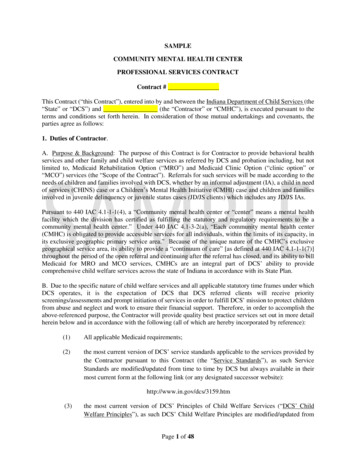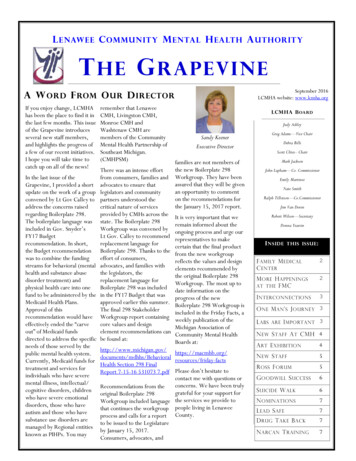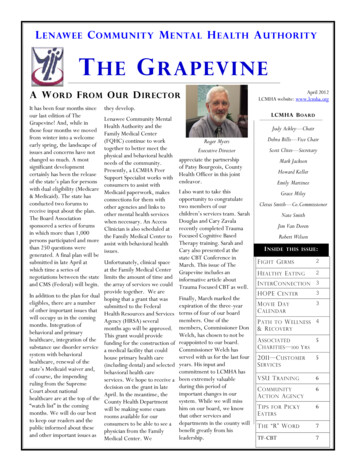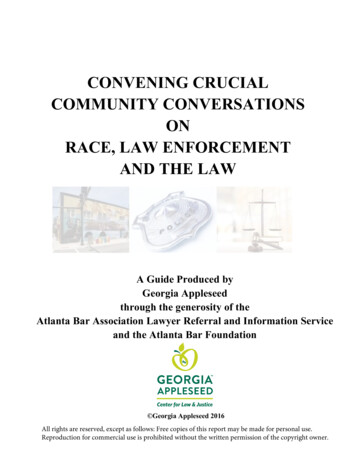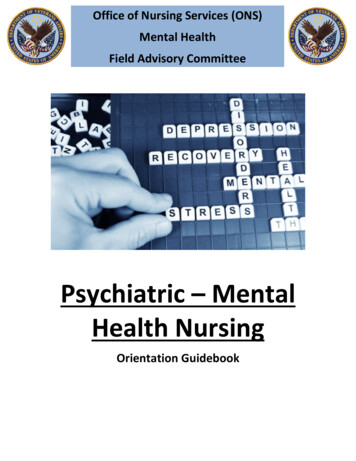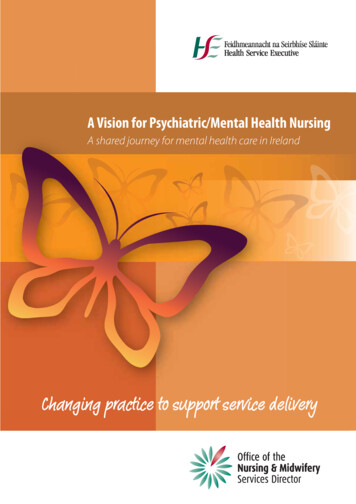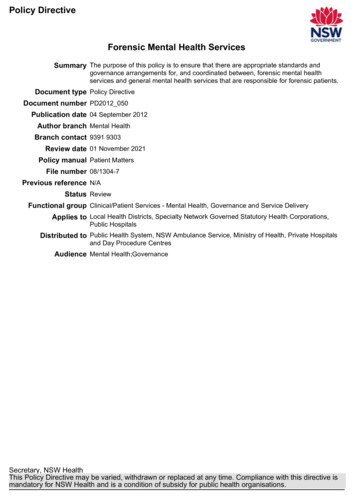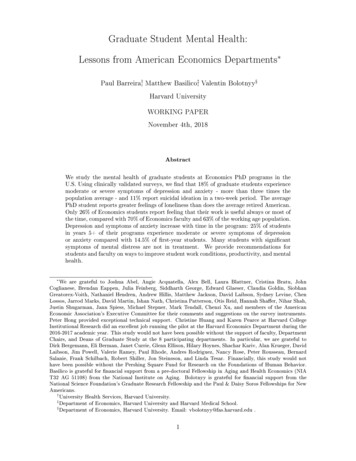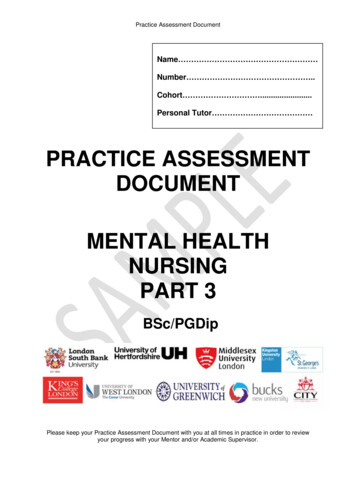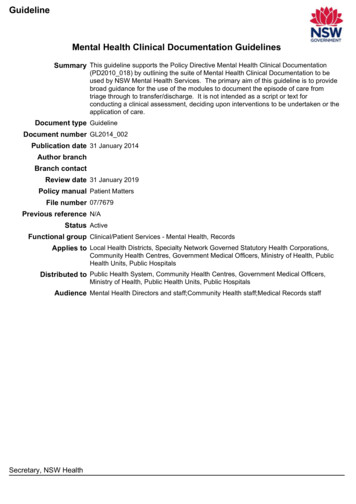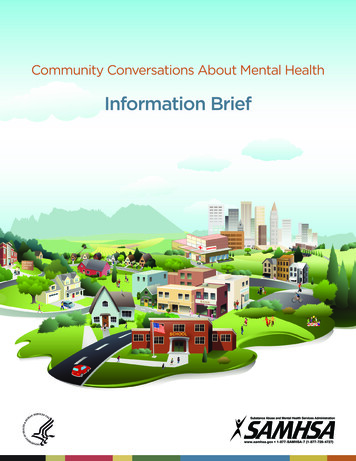
Transcription
Community Conversations About Mental HealthInformation Brief
On January 16, 2013, President Barack Obama directed Secretary Kathleen Sebelius of the U.S. Departmentof Health and Human Services and Secretary Arne Duncan of the U.S. Department of Education to launcha national conversation on mental health to reduce the shame and secrecy associated with mental illness,encourage people to seek help if they are struggling with mental health problems, and encourage individualswhose friends or family are struggling to connect them to help.Mental health problems affect nearly every family. Yet as a nation, we have too often struggled to have anopen and honest conversation about these issues. Misperceptions, fears of social consequences, discomfortassociated with talking about these issues with others, and discrimination all tend to keep people silent.Meanwhile, if they get help, most people with mental illnesses can and do recover and lead happy, productive,and full lives.This national conversation will give Americans a chance to learn more about mental health issues. Peopleacross the nation are planning community conversations to assess how mental health problems affect theircommunities and to discuss topics related to the mental health of young people. In so doing, they may alsodecide how they might take steps to improve mental health in their families, schools, and communities. Thiscould include a range of possible steps to establish or improve prevention of mental illnesses, promotion ofmental health, public education and awareness, early identification, treatment, crisis response, and recoverysupports available in their communities.Pamela S. Hyde, J.D.AdministratorSAMHSAPaolo del Vecchio, MSWDirectorCenter for Mental Health ServicesSAMHSA
C o m m u n i t y C o n ve r s a t i o n s A b o u t M e n t a l H e a l t hGoals and Objectives of theToolkit for Community ConversationsAbout Mental HealthThe Toolkit for Community Conversations About Mental Health is designed to helpindividuals and organizations who want to organize community conversations achievethree potential objectives: Get others talking about mental health to break down misperceptions and promoterecovery and healthy communities; Find innovative community-based solutions to mental health needs, with a focus onhelping young people; and Develop clear steps for communities to address their mental health needs in a waythat complements existing local activities.The Toolkit includes:1.An Information Brief section that provides data and other facts regarding mental healthand mental illness and how communities can improve prevention of mental illnesses,promotion of mental health, public education and awareness, early identification,treatment, crisis response, and recovery supports available in their communities.2.A Discussion Guide section that is intended for use in holding communityconversation meetings of 8-12 people each. (In a community f orum with moreparticipants, the audience would divide into groups of this size for much of theirtime together.) It provides discussion questions, sample views, ideas, and an overallstructure for dialogue and engagement on mental health issues.3.A Planning Guide section that describes a variety of ways in which people canfacilitate their community conversations and take next steps at the local level to raiseawareness about mental health and promote access to mental health services.Mental health issues in our communities—particularly for our youth—are complex andchallenging; but, by coming together and increasing our understanding and raising awareness,we can make a difference.
Information BriefThe Information Brief forCommunity ConversationsAbout Mental HealthThe Information Brief is designed to be used alongside the other elements of the Toolkitfor Community Conversations About Mental Health and provides data and informationto help community conversations participants consider key issues of importance totheir communities. The Information Brief follows the format of the Discussion Guidesection of the Toolkit for Community Conversations About Mental Health and has thefollowing sections: Session 1: Sharing Personal ExperiencesOpening Question: What does mental health mean to me? To us as acommunity? Session 2: Discussion of ChallengesOpening Question: What are the challenges and factors we should consider? Session 3: Exploration of How to RespondOpening Question: What can we do to support young people? Session 4: Community SolutionsOpening Question: What steps do we want to take as a community?
Community Conversations About Mental HealthInformation BriefTable of ContentsGoals and Objectives of the Toolkitfor Community ConversationsAbout Mental Health . iiThe Information Brief for CommunityConversations About Mental Health. iiiMental Health in the Community.7Research About the Mental Healthof Young People.10Session 2: Discussion of Challenges.11Terms and Definitions.1Session 3: Exploration of How to Respond.14Session 1: Sharing Personal Experiences.3Session 4: Community Solutions . 17Understanding the Basics.3Appendix: Helpful Resourcesand Websites. 19Attitudes and Beliefs AboutMental Health.6Reference List .20
C o m m u n i t y C o n ve r s a t i o n s A b o u t M e n t a l H e a l t hAcknowledgmentsThis guide was prepared for the Substance Abuse and Mental Health ServicesAdministration (SAMHSA) by Abt Associates and its subcontractors the DeliberativeDemocracy Consortium, and Everyday Democracy under contract number[HHSS283200700008I/HHSS28342002T] with SAMHSA, U.S. Department of Healthand Human Services (HHS). L. Wendie Veloz and Chris Marshall served as theGovernment Project Officers.DisclaimerThe views, opinions, and content of this publication are those of the author and do notnecessarily reflect the views, opinions, or policies of SAMHSA or HHS. The listing ofany non-Federal resources is not all-inclusive and inclusion in this publication does notconstitute endorsement by SAMHSA or HHS.Public Domain NoticeAll material appearing in this report is in the public domain and may be reproducedor copied without permission from SAMHSA. Citation of the source is appreciated.However, this publication may not be reproduced or distributed for a fee without thespecific, written authorization of the Office of Communications, SAMHSA, HHS.Electronic Access and Printed CopiesThis publication may be downloaded or ordered at http://store.samhsa.gov. Or callSAMHSA at 1-877-SAMHSA-7 (1-877-726-4727) (English and Español).Recommended CitationSubstance Abuse and Mental Health Services Administration, Community ConversationsAbout Mental Health: Information Brief. HHS Publication No. SMA-13-4763. Rockville,MD: Substance Abuse and Mental Health Services Administration, 2013.Originating OfficeOffice of Communications, Substance Abuse and Mental health ServicesAdministration, 1 Choke Cherry Road, Rockville, MD 20857. HHS Publication No.SMA-13-4763. Published July 2013.SAMHSA DescriptorThe Substance Abuse and Mental Health Services Administration (SAMHSA) is theagency within the U.S. Department of Health and Human Services that leads publichealth efforts to advance the behavioral health of the nation. SAMHSA’s mission is toreduce the impact of substance abuse and mental illness on America’s communities.
Information BriefTerms and DefinitionsBefore we start looking at these central questions, let’s define some terms that will beused heavily throughout this informational brief:Mental Health is a state of well-being in which an individual realizes his or her ownabilities, can cope with the normal stresses of life, can work productively, and isable to make a contribution to his or her community. In this positive sense, mentalhealth is the foundation for individual well-being and the effective functioning of acommunity.1Mental Illness is defined as “collectively all diagnosable mental disorders” or “healthconditions that are characterized by alterations in thinking, mood, or behavior (orsome combination thereof) associated with distress and/or impaired functioning.”Under these definitions, substance use might be classified as either a mental healthproblem or a mental illness, depending on its intensity, duration, and effects.2Mental Health Promotion consists of interventions to enhance the ability to achievedevelopmentally appropriate tasks and a positive sense of self-esteem, mastery, wellbeing, and social inclusion and to strengthen the ability to cope with adversity.3This ability to cope is referred to as resilience.Mental Health Treatment is the provision of specific intervention techniques by aprofessional for conditions identified in the most recent edition of the Diagnosticand Statistical Manual of Mental Disorders (DSM). These interventions shouldhave proven effectiveness, the ability to produce measurable changes in behaviorsand symptoms, and should be person- and family-centered and culturally andlinguistically appropriate.4Prevention is a step or set of steps along a continuum to promote individual, family,and community health; prevent mental and substance use disorders; support resilienceand recovery; and prevent relapse.51
2C o m m u n i t y C o n ve r s a t i o n s A b o u t M e n t a l H e a l t hRecovery is a process of change through which individuals improve their health andwellness, live a self-directed life, and strive to reach their full potential. People withmental illnesses can and do recover from these conditions, and hope plays an essentialpart in overcoming the internal and external challenges, barriers, and obstacles.Controlling or managing symptoms is part of this process. Reducing or eliminatingsubstance use is critical for recovery from addiction.6Recovery Support Services include a focus on providing for the health, housing,vocational, and social support needs of people with mental health problems. Theseinclude peer- and family-operated services.7Substance Abuse is defined as the use of alcohol or drugs despite negativeconsequences.8Substance Use is defined as the consumption of low or infrequent doses of alcoholand other drugs, sometimes called experimental, casual, or social use.9Trauma results from an event, series of events, or set of circumstances that isexperienced by an individual as physically or emotionally harmful or threatening andthat has lasting adverse effects on the individual’s functioning and physical, social,emotional, or spiritual well-being.10Young People/Youth are defined here as persons up to age 25.
Information BriefSession 1:Sharing PersonalExperiencesWhat Does Mental Health Mean to Me?To Us as a Community?There are many views and opinions about mental illnesses, their causes, and how wecan best treat and respond to these conditions. The following information providessome basic facts about mental health and mental illness to help participants beginthe conversation.Understanding the BasicsMental health plays an important role in your overall well-being. An estimated19.6 percent of Americans ages 18 and older—about one in five adults—willexperience a mental health problem this year.11 But studies show that most people withmental problems get better, and many recover completely.Mental health includes our emotional, psychological, and social well-being. It affectshow we think, feel, and act. It also helps determine how we handle stress, relate toothers, and make choices. Mental health is important at every stage of life, fromchildhood and adolescence through adulthood.Over the course of your life, you may experience mental health problems. Yourthinking, mood, and behavior could be affected.12Many factors contribute to mental health problems, including: Life experiences, such as trauma or a history of abuseBiological factors, such as genes or chemical imbalances in your brainFamily history of mental health problemsTaking care of one’s mental health is just as important as taking care of one’s physicalhealth. Overall health includes a well-balanced and nutritious diet, regular exercise,stress management, early and ongoing mental health services when needed, and takingtime to relax and enjoy family and friends. Finding a good balance between work andhome is important to mental and physical health.3
4C o m m u n i t y C o n ve r s a t i o n s A b o u t M e n t a l H e a l t hTypes of Mental Health ProblemsPeople can experience different types of mental health problems. Some can occur for a shorttime, and some occur over an on-going time period. Just as other health conditions, these arereal and diagnosable health conditions that affect and are affected by functioning of the brain,an organ of the body just like the kidney, liver, or heart. Mental health problems can affect yourthinking, mood, and behavior. Common types can include:13Anxiety DisordersPeople with anxiety disorders respond to certain objects or situations with fear and dread.Anxiety disorders can include obsessive-compulsive disorder, panic disorders, phobias, andPost-Traumatic Stress Disorder (PTSD).Attention Deficit Hyperactivity DisorderAttention deficit hyperactivity disorder (ADHD) is one of the most common childhooddisorders and can continue through adolescence and adulthood. Symptoms include difficultystaying focused and paying attention, difficulty controlling behavior, and hyperactivity (overactivity).Eating DisordersEating disorders involve extreme emotions, attitudes, and behaviors involving weight andfood. Eating
a national conversation on mental health to reduce the shame and secrecy associated with mental illness, encourage people to seek help if they are struggling with mental health problems, and encourage individuals whose friends or family are struggling to connect them to help. Mental health problems affect nearly every family. Yet as a nation, we have too often struggled to have an
